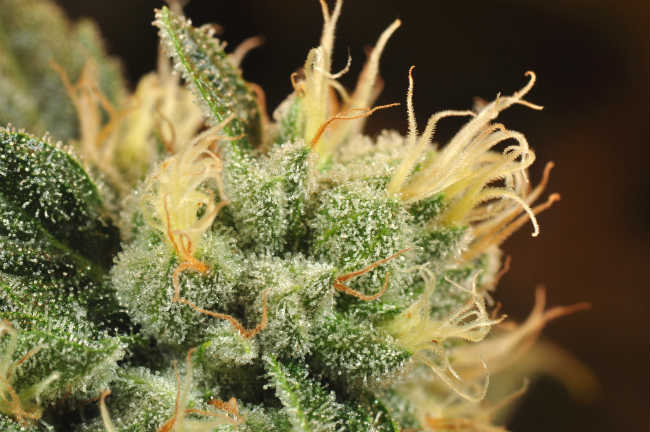
Monday October 1, 2018
By Erin Hiatt
 Education
Education
When it comes to the cannabis plant, tiny is mighty. In fact, the most miniscule elements of the plant, trichomes specifically, pack powerful punches of cannabinoids, compounds that provide healing benefits for inflammation, nausea, pain, and anxiety – plus terpenes, the fragrant oils that give cannabis strains their distinctive flavor and smells, like pine or citrus. At distant glance, trichomes may give cannabis a frosty appearance, but in actuality, that frostiness is due to the composition of trichomes.
Originating from the Greek word Tríchōma, meaning “growth of hair,” trichomes are extremely delicate, gooey and sticky crystals that, upon close inspection, resemble miniature mushrooms.
Trichomes protect many plant species from fungus, pests and hungry animals, and cannabis is no exception. They also protect cannabis from ultraviolet rays and variations in humidity. Trichomes come in different sizes and shapes, and those tiny mushroom-like heads are where the cannabinoids, terpenes, and flavonoids reside. There are several different types of trichomes, but those on cannabis tend to come in three varieties: bulbous, capitate-sessile and capitate-stalked. Let’s take a look at each one.
Capitate-Stalked Trichomes

Capitate-stalked trichomes are the largest and most plentiful of the three, and are visible to the human eye, at about 1/10 of a millimeter, or 100 micrometers. Capitate-stalked trichomes are made of a stalk and head, where the cannabinoids and terpenes are generated. Growers often look to these trichomes as a clue for when it’s time to harvest.
Capitate-Sessile Trichomes
These are slightly larger and more abundant than the bulbous variety, and come in at around 25-100 micrometers, about the width of wool fiber. Capitate-sessile trichomes most closely resemble a mushroom, with their globe-shaped heads and single stalks. The cells of capitate-sessile trichomes secrete cannabinoids and other compounds.
Bulbous Trichomes
You will definitely need a magnifying glass to identify the bulbous trichomes. At approximately 15 to 30 micrometers, that makes them about the width of a human hair. Bulbous trichomes appear on the surface of the cannabis plant and have a secretory head. They are the smallest and least prolific on the cannabis plant.
Speaking of Harvest
When a trichome is in the early stages of development, it will have a clear or translucent coloration. As the plant grows, the trichomes will also mature, changing from clear to cloudy, and finally, amber. When the trichomes turn cloudy, that indicates that the trichome has reached full maturation and cannabinoids are at their apex. It’s all downhill from there, as the trichomes, and the THC and CBD contained within, will begin to degrade. It is suggested that growers start their harvest when about half the trichomes become cloudy.

But proceed cautiously. Trichomes, and the essential oils contained within them, are incredibly delicate and easily damaged, especially when in the presence of touch, agitation, oxygen, heat, light and time. The best way to limit this damage is to carefully handle the flowers and to take proper care with trimming, drying and curing to help keep the trichomes intact.
Isolating Trichomes
Given the fragility of trichomes, extraction has become the go-to way to separate trichomes from the flower, extending its usability. There are many extraction methods, but the simplest (and least refined) one is to mechanically remove trichomes from the flower, which can be easily done with a three-chambered grinder. The resulting product, kief, can be collected and added to food, or as an extra kick to a joint or bowl.
Trichomes can be collected and made into more refined concentrates as well through solventless or solvent-based extraction, but this is certainly more labor intensive than a grinder and in the case of shatter, wax or live resin, where a butane or propane extraction method is used, much more dangerous (seriously, don’t try this at home). Leave shatter or wax to the professionals.

The simplest way to collect trichomes into concentrates is to do an ice water extraction. Add plant material to ice cold water, then agitate to separate the trichomes from the flower. This method requires filtering through various micron screens, and will give you a nice and clean final product. With a little time and patience, you can even make your own tinctures using a high-proof alcohol like Everclear. By soaking cannabis flowers for around 30-60 days, you’ll get a very usable tincture.
Trichomes can be consumed in many ways. You can vape, dab, take a tincture, roll your joint in kief, or try your hand at homemade solventless extraction. Either way, trichomes are incredible little cannabinoid factories and fierce cannabis plant protectors, so enjoy!
How do you utilize trichomes? Share your methods in the comments below!







